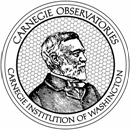
- Home
- Quick Facts
- Exposure Calculator
- Calibration
- Manual & Documents
- About Us
- Optics
- Mechanical
- Electronics
- Software
- Pictures
- Calendar
- Status
Technical Staff Links
FourStar Pointing
The FourStar field-of-view is about 11x11 arc-minutes. There is a narrow 60 arc-second guide strip along one edge and another narrow 60 arc-second strip on the opposite side for the Shack-Hartmann (SH) probe. The guider magnitude limits are approximately 12th-17th magnitude and the SH probe limits are about 10th-15th magnitude. The current telescope software uses the USNO-A1 catalog to find stars within the guide regions.
It takes about 30 s to run one SH iteration, 60 s for a faint star (16 mag). It is recommended to spend at least 1 minute in a position for the SH to tune the primary mirror. It is possible to spend 40 s in each location and then move to the next using a bright SH star. Also, it is possible to run the SH once and continue without it for a few minutes (up to ten) before the stellar PSF noticably degrades.
Dithering is recommended to remove detector artifacts and determine the sky background. The gaps between the arrays are about 19 arc-seconds, if filling these regions is important then a dither step size greater than 25" is recommended. Note: the guider fields are only 60" wide so dither sequences with steps sizes of order 25" begin to run the risk of moving out of range of the guider during a planned dither sequence (macro).
A FourStar fov file is available for Aladin which projects the FourStar and guider footprints on the sky to help plan observing strategies. If pointing, guiding, and constant tuning of the primary mirror are extremely critical for an observation then it is recommended to select a field and orientation that provide a suitable guide and SH star that are bright enough and near the centers of the guide regions.
Currently, any position angle can be specified. the default mode is "OFFSET" which means: North up, East left on the arrays. NOTE: since this is an ALT-AZ telescope, when viewing objects North of a declination of -29.0 degrees, the rotator angle will change to 180, or North down, East right.
 |
|---|

Carnegie Observatories, 813 Santa Barbara Street, Pasadena, California, 91101 USA
©Trustees of the Carnegie Institution of Washington
These Documentation pages are Design in Progress and content may change. Last updated: March 13, 2010
The Carnegie Observatories | Las Campanas Observatories | Contact Us